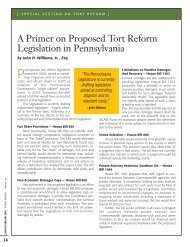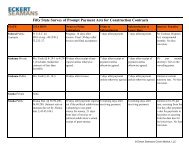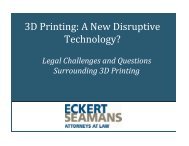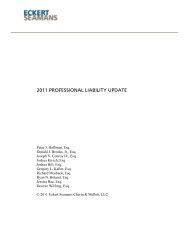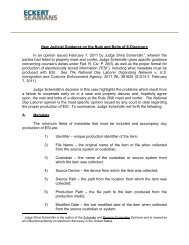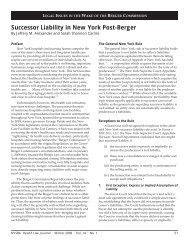found that the District Court was well within its rights to decline supplemental jurisdiction overthe state law claims of the defaulting defendants.In Byrne v. The Cleveland Clinic, 684 F. Supp. 2d 641 (E.D. Pa. 2010), the pro seplaintiff brought suit against defendant under the Emergency Medical Treatment and ActiveLabor Act (EMTALA), as well as a state law claim for breach of implied contract. Defendantsmoved to dismiss on multiple grounds, including plaintiff’s failure to file within the two yearstatutory period.The court notes that although a 12(b)(6) motion to dismiss does not specifically includethe statute of limitations defense, “the so-called ‘Third Circuit rule’ allows such a defense to beraised in a 12(b)(6) motion ‘if the time alleged in the statement of a claim shows that the cause ofactions has not been brought within the statute of limitation.’” Id. quoting Zankel v. TempleUniv., 245 Fed. Appx’ 196, 198 (3d Cir. 2007).The court also notes that in the case of a pro se litigant who files a complaint and whoseeks to proceed in forma pauperis, the constructive date of filing is the date that the court clerkreceives the complaint, not the date that the filing fee is paid, so long as the fee is eventually paideither by the litigant or the court grants the request to proceed in forma pauperis. The courtspecifically points out that the constructive date of filing is not the date the litigant mails thecomplaint or when the complaint is notarized.Although the docket listed the complaint as being filed on February 27, 2009, there was ahandwritten date of February 14, 2009 on the complaint, one day before the statute of limitationsran. The court acknowledged that although it could not yet be sure who wrote that date, thepossibility existed that it was the court clerk, in which case the complaint had been received andtherefore, constructively filed, within the statute of limitations. As the court could not make thedetermination of whether or not the complaint was timely filed based on the pleadings alone, thecourt held that the Third Circuit Rule did not bar the claim.The court held that it could not dismiss the breach of contract claim on the statute oflimitations grounds based on the same reasoning. It did, however, dismiss that claim on thegrounds that the plaintiff alleged merely a delay in treatment and not a breach based on thequality or result of the treatment.In Fine v. Checcio; Ward v. Rice, 870 A.2d 850 (Pa. 2005), the Supreme Court looked attwo cases, consolidated on appeal, in which Plaintiffs were patients that had sued dentists andalleged dental malpractice. In both cases, the dentist-Defendant moved for summary judgmentbased on the two year statute of limitations and the patient-Plaintiff raised the discovery rule andthe doctrine of fraudulent concealment. The Supreme Court ruled in both cases that dentist-Defendant was not entitled to summary judgment and issued two important holdings in thiscourse of their opinion.In Fine, Dr. Checcio had recommended that the patient’s four wisdom teeth be surgicallyextracted. Fine accepted this recommendation and signed a consent form with complications andconditions that could follow surgery, including numbness of the lip, tongue, chin and cheeks.Dr. Checcio removed the teeth on July 17, 1998. On that date Fine had numbness on both sides88
of his face. According to Fine, on the ten occasions he saw Dr. Checcio between the surgery andOctober 9, 1998, the doctor told him it could take up to six months for the numbness to subside.About a year after the surgery, Fine came to believe the persistent numbness was abnormal. Hecommenced suit against Dr. Checcio on August 8, 2000. Dr. Checcio raised the statute oflimitations as a defense in her answer and new matter and subsequently filed a motion forsummary judgment asserting that the action was time-barred. Fine asserted that there weredisputed, material facts as to whether the limitations period was tolled under the discovery ruleor the doctrine of fraudulent concealment.The trial court denied Dr. Checcio’s motion. After trial resulted in a verdict in favor ofFine, and denied post-trial motions, Dr. Checcio appealed. The Superior Court reversed, rulingthat the limitations period began to run on the date of surgery and that Fine’s action, therefore,was barred.In Ward, plaintiff had her wisdom teeth extracted by Dr. Rice on March 28, 1995.Immediately following the surgery, Plaintiff experienced some numbness and occasional tinglingin her lip. Plaintiff told Dr. Rice of her condition, and he assured her it would go away. Plaintiffcontinued to treat with Dr. Rice until May, 1995. He continued to assure her the problems shewas having would subside. Plaintiff asked Dr. Rice for a referral on July 5, 1995, but it was notuntil September 20, 1995 that he directed her to another doctor. Her first visit to the new doctoroccurred on October 11, 1995. On September 26, 1997, Plaintiff filed a writ of summons. Dr.Rice filed a motion for summary judgment based on the statute of limitations and Wardresponded that her action was timely because the record showed the statute had been tolled underthe discovery rule and the doctrine of fraudulent concealment.The trial court granted the motion. The Superior Court remanded the case for furtherproceedings after finding that the discovery rule applied and the trial court had erred indismissing the lawsuit as time-barred.Because the cases covered the same issues, the Supreme Court consolidated the appeals.The Supreme Court decision reviewed the settled aspects of the discovery rule and then notedthat it remained unsettled whether the rule requires that it be determined whether the injury andits cause were reasonably ascertainable at any point within the prescribed statutory period. Oneschool of thought was that if they were—even if this occurred one day before the statutory periodended—the discovery rule does not apply and the statute is not tolled. Another camp believedthat the discovery rule always applies to toll the statute if at the time the injury occurs, the injuryor its cause is neither known nor reasonably knowable.The Supreme Court held that “the discovery rule applies to toll the statute of limitationsin any case where a party neither knows nor reasonably should have known of his injury and itscause at the time his right to institute suit arises.” Id. at 859. To adopt the alternate position, thecourt reasoned, could lead in many instances to unreasonable and arbitrary results. It would also,the court explained, nullify the recognized purpose of the rule, which is to see to it that personswho are reasonably unaware of an injury that is not immediately ascertainable have essentiallythe same rights as those who suffer an immediately ascertainable injury. Id. at 860.89
- Page 3 and 4:
EMTALA CASES ......................
- Page 5:
Filing an Affidavit of Non-Involvem
- Page 8 and 9:
II.PROFESSIONAL LIABILITY - AN OVER
- Page 10 and 11:
The Superior Court reversed the tri
- Page 12 and 13:
to a third party pursuant to the st
- Page 14 and 15:
After approximately five months, De
- Page 16 and 17:
learned the day after the surgery t
- Page 18 and 19:
conduct to the delay in colon cance
- Page 20 and 21:
court admitted the expert’s testi
- Page 22 and 23:
(b)(c)other reasonable causes, incl
- Page 24 and 25:
corroborated his testimony. The cou
- Page 26 and 27:
husband’s estate. Plaintiff alleg
- Page 28 and 29:
Other notable federal cases arising
- Page 30 and 31:
The Superior Court found that in re
- Page 32 and 33:
§ 1303.512(b). The court, however,
- Page 34 and 35:
In Neidig v. United States, No. 07-
- Page 36 and 37:
Additionally, the Supreme Court not
- Page 38 and 39:
were not indicated for her conditio
- Page 40 and 41:
surgeon is the same as it would be
- Page 42 and 43:
It should be noted that the Superio
- Page 44 and 45: Finally, the court held that the tr
- Page 46 and 47: The Supreme Court of Pennsylvania r
- Page 48 and 49: nurses deviating from applicable st
- Page 50 and 51: certainty, the court reviews expert
- Page 52 and 53: Under Pennsylvania law, the Court n
- Page 54 and 55: testimony, Defendant presented his
- Page 56 and 57: Following Cooper v. Roberts, 286 A.
- Page 58 and 59: Plaintiff developed chronic diarrhe
- Page 60 and 61: where payment is made by Medicaid w
- Page 62 and 63: accomplished. In Valles v. Albert E
- Page 64 and 65: In 1980, the Pennsylvania Superior
- Page 66 and 67: Plaintiff had a routine monitoring
- Page 68 and 69: Plaintiff’s Contract ClaimsThe Co
- Page 70 and 71: is a failure to report changes in a
- Page 72 and 73: unit to assure post-surgical patien
- Page 74 and 75: sliced his wrist and arm with a raz
- Page 76 and 77: licensed professionals for whom the
- Page 78 and 79: (c)Limitations of Corporate Neglige
- Page 80 and 81: Even more recently, our Superior Co
- Page 82 and 83: (a)HMO IssuesIn McClellan v. Health
- Page 84 and 85: affidavit submitted by Defendants o
- Page 86 and 87: treatments while at VA’s faciliti
- Page 88 and 89: [s]ubstantively, we believe that a
- Page 90 and 91: The party claiming the benefit of t
- Page 92 and 93: deprive (him) of civil rights guara
- Page 96 and 97: With respect to fraudulent concealm
- Page 98 and 99: would be applied in situations wher
- Page 100 and 101: they had not raised them in the cou
- Page 102 and 103: (a)Informed ConsentUnder MCARE, a p
- Page 104 and 105: civil enforcement provisions and ma
- Page 106 and 107: MCARE also changes the manner in wh
- Page 108 and 109: whose death, in 2005, was allegedly
- Page 110 and 111: vicariously liable if the plaintiff
- Page 112 and 113: health center or its equivalent or
- Page 114 and 115: In Pennsylvania Medical Society, th
- Page 116 and 117: to any professional who is alleged
- Page 118 and 119: Since the 2005 amendments, there ha
- Page 120 and 121: ule, but who intentionally ignores
- Page 122 and 123: the original Complaint was delivere
- Page 124 and 125: foreclose all challenges against th
- Page 126 and 127: number of boxes), which was support
- Page 128 and 129: questions of professional judgment
- Page 130 and 131: deviated from any professional stan
- Page 132 and 133: The Third Circuit affirmed the Dist
- Page 134 and 135: claims and cross-claims remain agai
- Page 136 and 137: By an Amendatory Order dated March
- Page 138 and 139: The court acknowledged that there i
- Page 140 and 141: apply and that the trial court misa
- Page 142 and 143: Barbados had enough litigation-spec
- Page 144 and 145:
E. Preemption of Vaccine Design Def
- Page 146 and 147:
2. Pa. R. Civ. Pro. 1036.1 - Reinst
- Page 148 and 149:
Barrick, at *34-35.Furthermore, the
- Page 150 and 151:
(b) the utility of the defendant’
- Page 152 and 153:
2006). In this case, Plaintiffs bro
- Page 154 and 155:
B. Elements of a Cause of Action fo
- Page 156 and 157:
decision in Muhammad precluded Mr.
- Page 158 and 159:
considered speculative “only if t
- Page 160 and 161:
underlying cause of action involved
- Page 162 and 163:
In Capital Care Corp., the Superior
- Page 164 and 165:
The court found, however, to state
- Page 166 and 167:
of reasonable diligence. The standa
- Page 168 and 169:
not be set aside. On July 7, 2005,
- Page 170 and 171:
complete bar to recovery. Since a l
- Page 172 and 173:
On appeal, Plaintiffs claimed that
- Page 174 and 175:
In Liggon-Redding, 659 F.3d at 265,
- Page 176 and 177:
elieved of those minimum standards
- Page 178 and 179:
elevant to the proceedings, the com
- Page 180 and 181:
establish professional misconduct b
- Page 182 and 183:
Upholding the Superior Court’s Or
- Page 184 and 185:
Id.Rejecting revocation and suspens
- Page 186 and 187:
order as a sanction under Rule 4019
- Page 188:
{1009912]182




